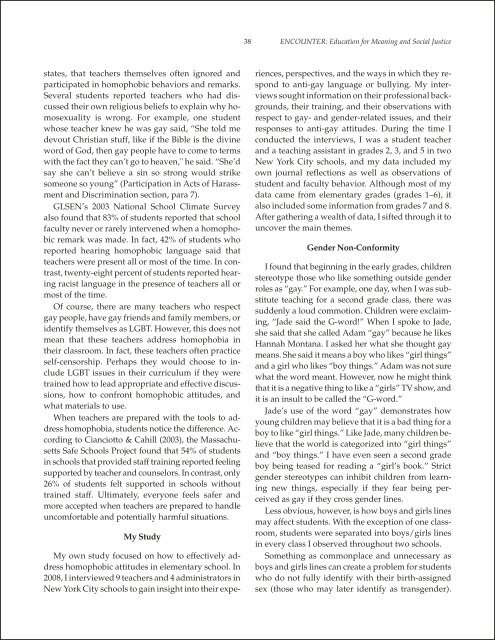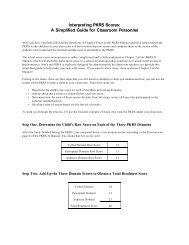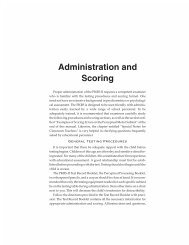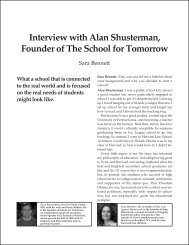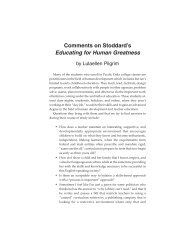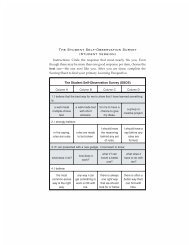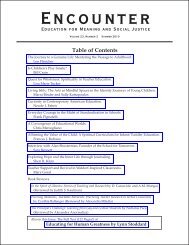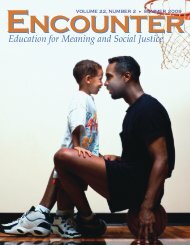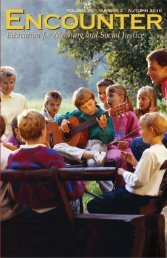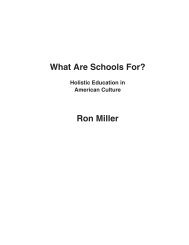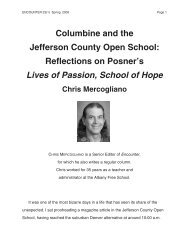Jane Goodall - Great Ideas in Education
Jane Goodall - Great Ideas in Education
Jane Goodall - Great Ideas in Education
You also want an ePaper? Increase the reach of your titles
YUMPU automatically turns print PDFs into web optimized ePapers that Google loves.
38 ENCOUNTER: <strong>Education</strong> for Mean<strong>in</strong>g and Social Justice<br />
states, that teachers themselves often ignored and<br />
participated <strong>in</strong> homophobic behaviors and remarks.<br />
Several students reported teachers who had discussed<br />
their own religious beliefs to expla<strong>in</strong> why homosexuality<br />
is wrong. For example, one student<br />
whose teacher knew he was gay said, “She told me<br />
devout Christian stuff, like if the Bible is the div<strong>in</strong>e<br />
word of God, then gay people have to come to terms<br />
with the fact they can’t go to heaven," he said. “She’d<br />
say she can’t believe a s<strong>in</strong> so strong would strike<br />
someone so young” (Participation <strong>in</strong> Acts of Harassment<br />
and Discrim<strong>in</strong>ation section, para 7).<br />
GLSEN’s 2003 National School Climate Survey<br />
also found that 83% of students reported that school<br />
faculty never or rarely <strong>in</strong>tervened when a homophobic<br />
remark was made. In fact, 42% of students who<br />
reported hear<strong>in</strong>g homophobic language said that<br />
teachers were present all or most of the time. In contrast,<br />
twenty-eight percent of students reported hear<strong>in</strong>g<br />
racist language <strong>in</strong> the presence of teachers all or<br />
most of the time.<br />
Of course, there are many teachers who respect<br />
gay people, have gay friends and family members, or<br />
identify themselves as LGBT. However, this does not<br />
mean that these teachers address homophobia <strong>in</strong><br />
their classroom. In fact, these teachers often practice<br />
self-censorship. Perhaps they would choose to <strong>in</strong>clude<br />
LGBT issues <strong>in</strong> their curriculum if they were<br />
tra<strong>in</strong>ed how to lead appropriate and effective discussions,<br />
how to confront homophobic attitudes, and<br />
what materials to use.<br />
When teachers are prepared with the tools to address<br />
homophobia, students notice the difference. Accord<strong>in</strong>g<br />
to Cianciotto & Cahill (2003), the Massachusetts<br />
Safe Schools Project found that 54% of students<br />
<strong>in</strong> schools that provided staff tra<strong>in</strong><strong>in</strong>g reported feel<strong>in</strong>g<br />
supported by teacher and counselors. In contrast, only<br />
26% of students felt supported <strong>in</strong> schools without<br />
tra<strong>in</strong>ed staff. Ultimately, everyone feels safer and<br />
more accepted when teachers are prepared to handle<br />
uncomfortable and potentially harmful situations.<br />
My Study<br />
My own study focused on how to effectively address<br />
homophobic attitudes <strong>in</strong> elementary school. In<br />
2008, I <strong>in</strong>terviewed 9 teachers and 4 adm<strong>in</strong>istrators <strong>in</strong><br />
New York City schools to ga<strong>in</strong> <strong>in</strong>sight <strong>in</strong>to their experiences,<br />
perspectives, and the ways <strong>in</strong> which they respond<br />
to anti-gay language or bully<strong>in</strong>g. My <strong>in</strong>terviews<br />
sought <strong>in</strong>formation on their professional backgrounds,<br />
their tra<strong>in</strong><strong>in</strong>g, and their observations with<br />
respect to gay- and gender-related issues, and their<br />
responses to anti-gay attitudes. Dur<strong>in</strong>g the time I<br />
conducted the <strong>in</strong>terviews, I was a student teacher<br />
and a teach<strong>in</strong>g assistant <strong>in</strong> grades 2, 3, and 5 <strong>in</strong> two<br />
New York City schools, and my data <strong>in</strong>cluded my<br />
own journal reflections as well as observations of<br />
student and faculty behavior. Although most of my<br />
data came from elementary grades (grades 1–6), it<br />
also <strong>in</strong>cluded some <strong>in</strong>formation from grades 7 and 8.<br />
After gather<strong>in</strong>g a wealth of data, I sifted through it to<br />
uncover the ma<strong>in</strong> themes.<br />
Gender Non-Conformity<br />
I found that beg<strong>in</strong>n<strong>in</strong>g <strong>in</strong> the early grades, children<br />
stereotype those who like someth<strong>in</strong>g outside gender<br />
roles as “gay.” For example, one day, when I was substitute<br />
teach<strong>in</strong>g for a second grade class, there was<br />
suddenly a loud commotion. Children were exclaim<strong>in</strong>g,<br />
“Jade said the G-word!” When I spoke to Jade,<br />
she said that she called Adam “gay” because he likes<br />
Hannah Montana. I asked her what she thought gay<br />
means. She said it means a boy who likes “girl th<strong>in</strong>gs”<br />
and a girl who likes “boy th<strong>in</strong>gs.” Adam was not sure<br />
what the word meant. However, now he might th<strong>in</strong>k<br />
that it is a negative th<strong>in</strong>g to like a “girls” TV show, and<br />
it is an <strong>in</strong>sult to be called the “G-word.”<br />
Jade’s use of the word “gay” demonstrates how<br />
young children may believe that it is a bad th<strong>in</strong>g for a<br />
boy to like “girl th<strong>in</strong>gs.” Like Jade, many children believe<br />
that the world is categorized <strong>in</strong>to “girl th<strong>in</strong>gs”<br />
and “boy th<strong>in</strong>gs.” I have even seen a second grade<br />
boy be<strong>in</strong>g teased for read<strong>in</strong>g a “girl’s book.” Strict<br />
gender stereotypes can <strong>in</strong>hibit children from learn<strong>in</strong>g<br />
new th<strong>in</strong>gs, especially if they fear be<strong>in</strong>g perceived<br />
as gay if they cross gender l<strong>in</strong>es.<br />
Less obvious, however, is how boys and girls l<strong>in</strong>es<br />
may affect students. With the exception of one classroom,<br />
students were separated <strong>in</strong>to boys/girls l<strong>in</strong>es<br />
<strong>in</strong> every class I observed throughout two schools.<br />
Someth<strong>in</strong>g as commonplace and unnecessary as<br />
boys and girls l<strong>in</strong>es can create a problem for students<br />
who do not fully identify with their birth-assigned<br />
sex (those who may later identify as transgender).


